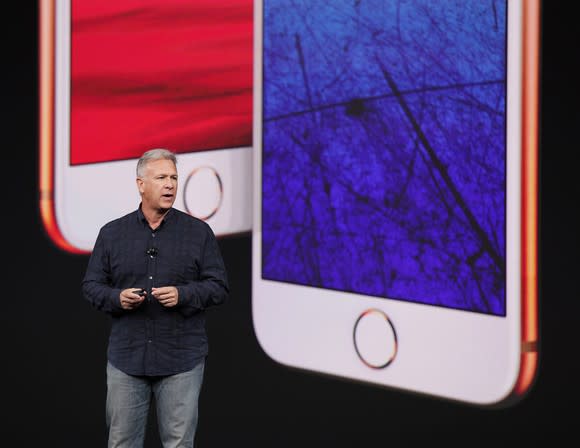Why This Apple Inc. 6.1-Inch iPhone Rumor Makes a Lot of Sense
About a week ago, KGI Securities analyst Ming-Chi Kuo reported that Apple (NASDAQ: AAPL) plans to launch an iPhone with a 6.1-inch liquid crystal display (LCD) next year. The device, which is reportedly one of three new iPhones slated to launch next year, is supposedly intended to serve as a device priced similarly to this year's iPhone 8 but with key selling points, such as a TrueDepth camera and a full-face display, lifted from this year's pricier iPhone X.
Kuo says the display found on this upcoming 6.1-inch iPhone will sport a pixel density of between 320 and 330 pixels per inch. Pixel density is effectively a measure of how sharp a display is -- the higher the number, the sharper the display.

Image source: Apple.
A figure within that range would mean the display on the 6.1-inch iPhone would be about as sharp as the display on this year's iPhone 8, which has a density of 326 pixels per inch. and duller than the display on the iPhone 8 Plus and its 401 pixels per inch.
Here's why that rumor makes perfect sense.
Solving Apple's OLED conundrum
The display on Apple's iPhone X has a pixel density of 458 pixels per inch, and the display on the rumored larger-screen version of the iPhone X that's expected to launch next year is rumored to sport a pixel density of between 480 and 500 pixels per inch.
While these numbers give the impression that the displays on the iPhone X and the rumored larger-screen version are much sharper than the displays on the iPhone 8 and 8 Plus, that's not strictly true.
On the LCDs Apple uses the iPhone 8 and iPhone 8 Plus, each pixel is made up of red, green, and blue sub-pixels. That means the densities of each of those sub-pixels is the same as the display's overall pixel density.

Image source: Apple.
That's not the case for the organic light-emitting diode (OLED) displays that are found on the current iPhone X or will be found on the future high-end iPhones. On those displays, the number of green subpixels matches the total number of pixels, but the number of red and blue subpixels is substantially lower.
DisplayMate says the subpixel densities of the red and blue subpixels on the iPhone X's OLED display is just 324 subpixels per inch, the figure derived by dividing the total pixel count by the square root of two.
While Apple does a lot of work to try to mitigate the fact that the red and blue subpixel density is merely on par with that of the iPhone 8's display, the fact is that the lower-end iPhone 8 Plus has, in some ways, a sharper display than the iPhone X does.
Next year's larger iPhone X, with its 6.46-inch display, is expected to have an OLED display with a pixel density of between 480 and 500 pixels per inch. That means the red and blue subpixel density on the display will be better than that on the iPhone 8 at between 339 and 353 subpixels per inch, but they'd still be lower than those on the display of the iPhone 8 Plus.
So by restricting next year's 6.1-inch LCD iPhone to a display with pixel densities of between 320 and 330 pixels per inch, Apple ensures that the displays on the higher-end OLED iPhones have unequivocally sharper displays than the one on the LCD iPhone.
Ultimately, for a proper product segmentation strategy to work, a company needs to ensure that the higher-end products in a lineup are, in every way, equal or superior to the lower-priced products.
Other benefits, too
Although keeping the pixel density on the LCD iPhone relatively low is good for Apple's iPhone segmentation strategy, there are other benefits to choosing a display with lower pixels per inch.
Fewer pixels means lower power consumption. For next year's LCD iPhone, Apple can choose to either take that power savings and translate it into better battery life -- a selling point -- or it can take those power savings and use a smaller battery to save on manufacturing costs as well as space in the phone.
On top of that, a lower-resolution display is easier for a graphics processor to drive, since the processing power required to render graphics-intensive applications such as 3D games goes up as pixel count goes up. That means a weaker graphics processor can be used while still enabling a smooth user experience, paving the way for Apple to use the older, cheaper A11 Bionic inside the LCD iPhone instead of the newer, more expensive A12 chip -- potentially boosting Apple's per-device profit margins.
More From The Motley Fool
6 Years Later, 6 Charts That Show How Far Apple, Inc. Has Come Since Steve Jobs' Passing
Why You're Smart to Buy Shopify Inc. (US) -- Despite Citron's Report
Ashraf Eassa has no position in any of the stocks mentioned. The Motley Fool owns shares of and recommends Apple. The Motley Fool has the following options: long January 2020 $150 calls on Apple and short January 2020 $155 calls on Apple. The Motley Fool has a disclosure policy.

